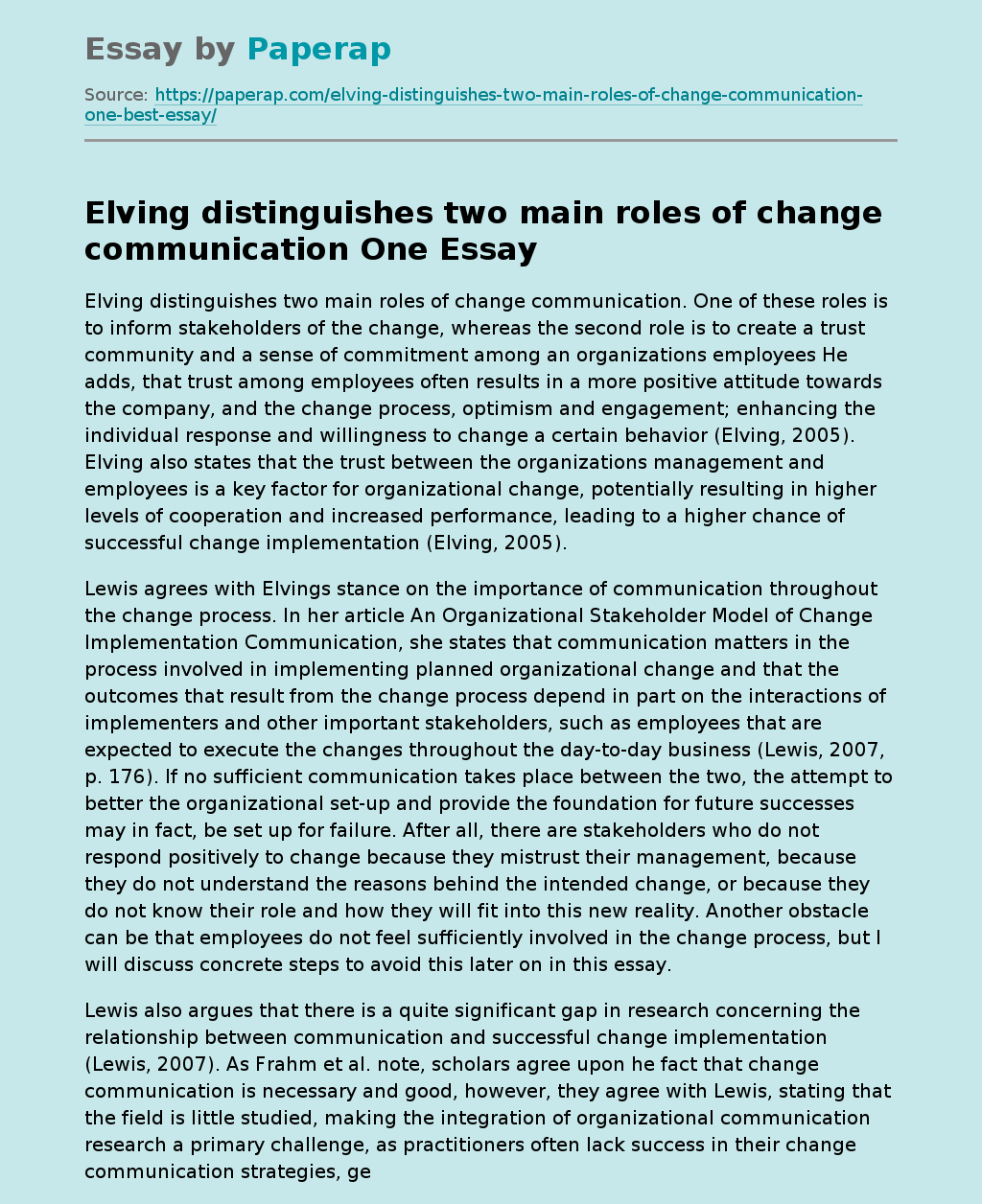Communicating to Enhance Trust and Change Receptivity
Elving distinguishes two main roles of change communication. One of these roles is to inform stakeholders of the change, whereas the second role is to create a trust community and a sense of commitment among an organizations employees He adds, that trust among employees often results in a more positive attitude towards the company, and the change process, optimism and engagement; enhancing the individual response and willingness to change a certain behavior (Elving, 2005). Elving also states that the trust between the organizations management and employees is a key factor for organizational change, potentially resulting in higher levels of cooperation and increased performance, leading to a higher chance of successful change implementation (Elving, 2005).
Lewis agrees with Elvings stance on the importance of communication throughout the change process. In her article An Organizational Stakeholder Model of Change Implementation Communication, she states that communication matters in the process involved in implementing planned organizational change and that the outcomes that result from the change process depend in part on the interactions of implementers and other important stakeholders, such as employees that are expected to execute the changes throughout the day-to-day business (Lewis, 2007, p.
176).
If no sufficient communication takes place between the two, the attempt to better the organizational set-up and provide the foundation for future successes may in fact, be set up for failure. After all, there are stakeholders who do not respond positively to change because they mistrust their management, because they do not understand the reasons behind the intended change, or because they do not know their role and how they will fit into this new reality.
Another obstacle can be that employees do not feel sufficiently involved in the change process, but I will discuss concrete steps to avoid this later on in this essay.
Lewis also argues that there is a quite significant gap in research concerning the relationship between communication and successful change implementation (Lewis, 2007). As Frahm et al. note, scholars agree upon he fact that change communication is necessary and good, however, they agree with Lewis, stating that the field is little studied, making the integration of organizational communication research a primary challenge, as practitioners often lack success in their change communication strategies, generating a need for a sufficient theoretical framework to better guide these communication efforts (Frahm et al., 2007, p. 371). In her earlier work, Lewis also raised this concern.
In Advice on Communicating During Organizational Change, Lewis et al. reviewed samples of popular bestselling books within the field of change communication to extract patterns and general strategies for communicating effectively during change implementation. Their findings included that a lot of books have been written from practitioners perspective, sometimes including rather vague advice, yet, academia appears to have taken only limited interest in the topic (Lewis et al., 2006).
As mentioned previously, the rate at which organizations need to adjust and implement changes is picking up pace and more and more employees are expected to adapt to the new reality of embracing constant willingness to change previously learned behaviors. To ensure high readiness for change among employees, organizations have to make sure to communicate with their employees for the desired success of their transformation efforts. Readiness for change consists of three intertwined building blocks, including the readiness of the individual employee who feels confident in his or her own abilities, the perceived readiness of the organization to change its set ways, and the actual ability of the organization to implement the change (Vakola, 2012).
As Lines et al. note, in an ever more chaotic world, distrust becomes the overarching attitude (Lines et al., 2005, p. 222). With an increasing shift towards a more globalized workforce, constant restructuring and reorganizing companies and higher speed when it comes to implementing these changes, trust in the organization and its leaders becomes crucial in creating and maintaining good employment relationships (Lines et al., 2005). But how can companies communicate effectively to ensure that they remain their employees trust in times of such great uncertainty?
In their article Navigating Change: Employee Communication in Times of Instability, DuFrene and Lehman acknowledge that while change is inevitable and necessary for companies to remain competitive, employees can often perceive it in a negative light, responding with feelings ranging anywhere from anger to betrayal and grief instead of the desired change receptivity (DuFrene et al., 2014). Change receptivity is a term that is used frequently throughout the scholarly articles discussing change communication, with positive change receptivity being one of the main desired outcomes of these communication efforts.
In the article First Steps: Linking Change Communication to Change Receptivity, authors Frahm and Brown, define this term as a number of responses to change, ranging from negative to positive, that describes a measurement of how receptive an individual or a group is to a change (Frahm et al., 2007, p. 374). As mentioned previously, Van den Heuvel et al. state that sufficient communication can be a crucial denominator in increasing employee trust, which can lead to greater willingness to adjust and respond positively to the implemented change. The authors argue that empirical data shows that employees who feel adequately informed about the change process will respond with greater psychological contract fulfillment, and perceived need for change (Van den Heuvel et al., 2015, p. 402).
Communicating to Enhance Trust and Change Receptivity. (2019, Nov 29). Retrieved from https://paperap.com/elving-distinguishes-two-main-roles-of-change-communication-one-best-essay/

